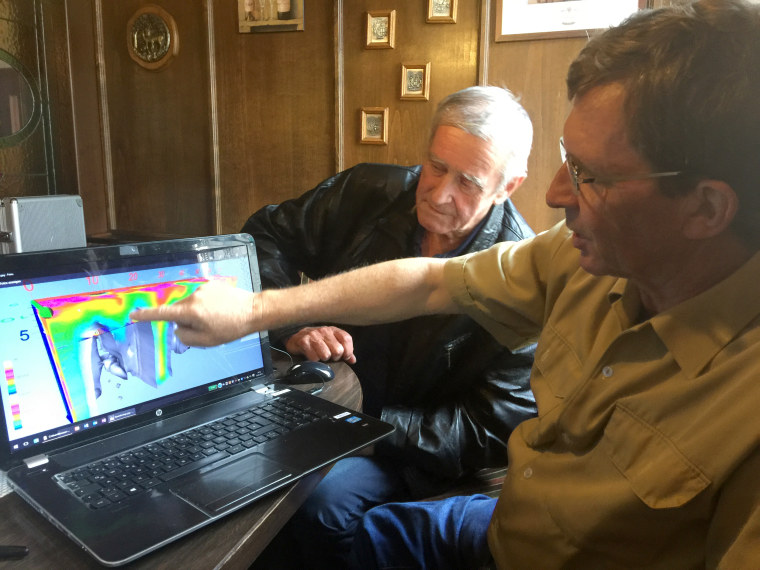ARNSTADT, Germany — They hunt for jewels and gold, the long-hidden plunder of Nazi lore. Now hobby historians in Germany believe they have an urgent case of potentially catastrophic proportions — secret nuclear bombs.
Deep inside the Thuringian Forest, 70-year-old Peter Lohr and two friends have been scanning the surface with "earth radar" and "geomagnetic" technology after one of Lohr's companions found Allied aerial surveillance photos of what they believe is a Nazi storage facility.

“What did the Nazis really do here? There are so many unanswered questions,” said 67-year-old Walter Boegenhold, a local resident interested in military history who has heard stories about Hitler’s secret projects in the region since his teenage years.
The team’s initial surface scans produced colorful images of what appears to be bomb-shaped metal housing, which led Lohr and Boegenhold to partner with explosive ordnance disposal expert Ralf Ehmann, 60.
“After conducting geomagnetic scans and carefully looking at all the images, I believe that we have Fat Man bombs buried below the surface,” Ehmann told NBC News.
“Fat Man” was the name for the plutonium bomb dropped by U.S. planes on the Japanese city of Nagasaki in 1945. Ehmann believes a similar nuclear bomb was developed by the Nazis.
Local authorities, however, think that's hogwash.
Officials conducted a "broad examination" after “being alerted to a suspected case of nuclear weaponry in the Jonas valley," the city of Arnstadt said in a statement, but they later determined that there was no evidence that “would confirm the suspicion."
Moreover, officials placed a ban on further searches — stating that the area is a designated nature reserve and that the “departure from regular paths, as well as excavations and drilling are strictly forbidden.”
Other historical sleuths have experienced similar resistance.
A former employee of Germany’s BND foreign intelligence service was denied access to the catacombs of a 13th-century Czech castle where he believes a jewel-encrusted "Amber Room" was hidden at the end of WWII.
“At first, local government officials categorically denied that Frydlandt castle has cellars, then they admitted their existence when we confronted them with photos,” said Erich Stenz, 69.
“This smells of conspiracy,” he said.
Stenz and his partner Georg Mederer, 65, were searching based on a tip-off from a former cook at the castle who said she saw Hitler's SS soldiers carrying dozens of unmarked crates into the cellars in February 1945.
The pair, from the southern German state of Bavaria, believe that sheet music could hold the key to finding the priceless Nazi treasure. Like others before them, Strenz and Mederer believe that Hitler's private secretary, Martin Bormann, hid clues about its location in an annotated score of the “March Impromptu” by composer Gottfried Federlein.
Stenz, who led special operations while working for the BND, says he is not a treasure hunter but somebody who wants “to bring the truth to light.”
There's also another group of retirees convinced the Amber Room lies in former bunkers underneath the western German city of Wuppertal.
Karl-Heinz Kleine, leader of the group, deployed ground-penetrating radar on a recent excursion and detected “anomalies” 40 feet below the surface. His team immediately began digging — again.
“I am convinced that I will find the Amber Room here someday,” said Kleine, who has been “on a mission” since 2008 — only pausing his searches when “money is tight.”
"The Amber Room is a bit like the Loch Ness monster," historian and filmmaker Guido Knopp told NBC News.
The award-winning journalist, who wrote the book “The Amber Room — On the Trail of a Myth” and produced many historic documentaries for German broadcaster ZDF on the Nazi era, said he had received dozens of clues on the whereabouts or the famous treasure during his television career.
“[If I'd] started to dig in all those places, I would have needed three lives,” Knopp said.
He added that it's not unlikely treasure hunters will find some kind of relics from Nazi times, but he does not believe that the Amber Room will ever be found.
And when it comes to possible nuclear warheads, Knopp said that there “is no clear evidence that the Nazis were able to build a nuclear bomb.”
“There are many legends and myths, and those who search, just hope for a bit of glory,” Knopp added.
But the nuke hunters of Thuringia have vowed not to give up. They recently presented their findings in a formal letter to the governor of the eastern German state.
Ehmann believes the local authorities conducted their tests in the wrong place and that residents in a three-mile radius pf the site could be threatened by a rotting nuclear weapon.
“We are only trying to save the lives of 20,000 people in the region,” Ehmann said.
